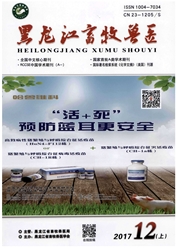

 中文摘要:
中文摘要:
研究冷应激条件下荷斯坦奶牛和三河牛的维持行为和抗氧化性能的变化规律,为奶牛选育和冬季饲养管理提供参考。选取第2胎的荷斯坦奶牛和三河牛各12头,随机分为4个处理组:分别对舍内(7℃~12℃)和舍外(-30℃~-16℃)荷斯坦奶牛和三河牛进行为期6d的行为观察和记录,在第7天早晨各组奶牛空腹进行尾部静脉采血测定抗氧化指标。结果表明,舍外冷应激环境条件下,荷斯坦奶牛和三河牛的卧息时间、反刍时间、排尿次数和排便次数显著性增加(P〈0.05),站立/游走时间和呼吸频率显著性降低(P〈0.05);同时血清T-SOD和CuZn-SOD的活力显著降低(P〈0.05),MDA含量显著增多(P〈0.05);另外,奶牛品种之间的维持行为和抗氧化性能无显著差异(P〉0.05),但总体趋势是荷斯坦奶牛各项测定指标变化略大于三河牛。结果显示,冷应激能够显著改变荷斯坦奶牛与三河牛的躺卧息、反刍和站立/游走等维持行为和抗氧化性能,而三河牛比荷斯坦奶牛更能适应高寒天气。
 英文摘要:
英文摘要:
This experiment was conducted to study the maintenance behavior and antioxidative function in Holstein cows and Sanhe cattle suffering cold stress,and to provide the reference for dairy cow breeding,feeding and management in the winter.Twelve Holstein cows and Sanhe cattle with second parity were randomly assigned to four treatments:the control groups of indoor Holstein cows and Sanhe cattle,the stress groups of outdoor Holstein cows and Sanhe cattle.There were six days to observe and record behaviors when being indoor(7℃-12 ℃)and outdoor(-30℃--16 ℃),then to measure antioxidant indexes after intravenous blood collection on 7th day.The results showed that when Holstein cows and Sanhe cattle suffered cold stress the time of resting and rumination,frequency of urination and defecation were significantly increased(P0.05),the time of walking/standing and breathing rate were significantly reduced(P0.05).In addiction,the vigor of serum T-SOD and CuZn-SOD were significantly decreased(P0.05),and MDA contents were significantly increased(P0.05).Moreover,maintenance behavior and antioxidative function between two breeds were not significantly different(P0.05),but every index variation of Holstein cows was slightly larger than that of Sanhe cattle.These results indicated that cold stress could significantly change the resting,ruminantion and walking/standing of maintenance behavior and antioxidative function of Holstein cows and Sanhe cattle,and Sanhe cattle were more easily adapted to cold weather more than Holstein cows.
 同期刊论文项目
同期刊论文项目
 同项目期刊论文
同项目期刊论文
 期刊信息
期刊信息
